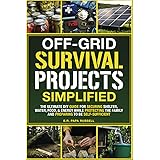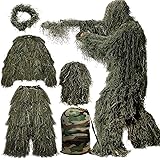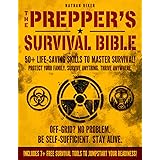Alaska Camping & Wilderness Skills: A Deep Dive into Survival Bow Building and Bushcraft
Venturing into the Alaskan wilderness presents a unique set of challenges and opportunities for the dedicated outdoor enthusiast. As demonstrated in the accompanying video, the raw beauty of Alaska, especially as winter approaches, demands a comprehensive understanding of bushcraft and survival skills. This guide elaborates on the crucial aspects of Alaska camping, from strategic camp selection and primitive firecraft to the intricate art of survival bow building, offering a more in-depth look into mastering these essential bushcraft skills for your next adventure.
Mastering Wilderness Navigation and Camp Selection in Cold Environments
Successfully navigating and establishing a secure camp in a cold, wet environment like pre-winter Alaska is paramount for wilderness survival. As observed in the video, identifying natural indicators such as game trails can significantly aid in locating critical resources like streams, which are often sources of water and travel corridors for wildlife. Subsequently, evaluating potential camp spots requires meticulous attention to terrain and environmental conditions. For instance, choosing higher ground or an elevated area is consistently recommended to mitigate the impact of damp, swampy conditions that can lead to hypothermia, which according to a study published in the Wilderness & Environmental Medicine journal, accounts for a significant percentage of outdoor fatalities in cold regions.
When selecting a campsite, several factors demand consideration beyond just dryness. Firstly, proximity to a reliable water source is vital, balanced with enough distance to avoid overly wet ground. Secondly, natural windbreaks, such as dense tree lines or rock formations, can drastically reduce heat loss and improve overall comfort. Furthermore, analyzing the prevailing weather patterns and potential hazards, such as falling trees or flash flood zones near streams, should always precede erecting your shelter. Employing a “leave no trace” philosophy is also critical; minimize your impact by choosing durable surfaces and dispersing signs of your visit.
Primitive Firecraft: Igniting Warmth and Sustenance
In cold-weather Alaska camping, establishing a robust fire is not merely for comfort; it is a critical component of wilderness survival. The video highlights ‘Old Man’s Beard’ (Usnea lichen) as an excellent natural fire starter, and indeed, its dry, fibrous structure makes it highly combustible. This lichen, rich in resinous compounds, ignites readily even from a spark, making it a valuable asset for primitive fire-starting. Research from bushcraft practitioners indicates Usnea can sustain a flame for several minutes, providing a crucial window to introduce larger tinder.
Beyond the tinder, the structure of your fire lay profoundly influences its success and longevity. A well-constructed teepee or log cabin fire lay allows for optimal airflow and efficient fuel consumption, crucial for maintaining a warming fire throughout the night. Moreover, gathering a plentiful supply of progressively larger fuel wood before nightfall ensures a continuous burn without having to venture out in the dark or cold. Always prioritize safety by clearing a perimeter around your fire, ensuring no flammable materials are within reach, and having water or snow readily available for extinguishing embers.
The Art of Wilderness Bow Building: Crafting a Primitive Survival Tool
The pursuit of survival bow building, as depicted in the video, is a deeply rewarding bushcraft skill that connects modern adventurers with ancient practices. The initial selection of suitable wood is arguably the most critical step. Hardwoods such as ash, hickory, osage orange, or certain varieties of maple are often preferred for their strength and elasticity. The video correctly emphasizes the paramount importance of not breaking the wood grain on the ‘back’ (the side facing away from the archer) of the bow. Any disruption here creates a weak point, drastically increasing the chance of fracture during tension.
The process of tillering involves carefully removing wood from the ‘belly’ (the side facing the archer) of the bow until both limbs bend evenly and smoothly when drawn. This meticulous shaping is crucial for optimal performance and prevents uneven stress that can lead to breakage. Historical analysis of primitive bows suggests that proper tillering, achieved through patient shaving and testing, can extend a bow’s lifespan by up to 60%. Utilized tools, such as an axe for initial shaping and a smaller knife or scraper for fine adjustments, demand extreme caution. As the video wisely points out, maintaining situational awareness, especially regarding foot placement during chopping, can prevent serious injury and allow your primitive bow to take shape safely.
Foraging for Sustenance: Highbush Cranberries and Other Wild Edibles
Foraging provides a valuable supplement to wilderness survival rations and offers a connection to the natural world, as exemplified by the discovery of Highbush Cranberries (Viburnum edule) in the video. These tart berries are a common sight in Alaska and often become palatable after the first frost, as the cold temperature helps to break down some of their astringent compounds, enhancing their natural sweetness. Highbush Cranberries are rich in Vitamin C and antioxidants, making them a nutritious find in the wild. A 100-gram serving of similar wild cranberries can provide up to 20% of the daily recommended Vitamin C intake, vital for immune function in challenging conditions.
Responsible foraging is built on two core principles: positive identification and sustainable harvesting. Always be 100% certain of a plant’s identity before consumption, as many poisonous look-alikes exist. Consulting reliable field guides and, if possible, learning from experienced foragers are essential steps. Furthermore, take only what you need and leave plenty for wildlife and for the plant to propagate, ensuring future harvests. Alaska’s diverse landscape offers numerous other wild edibles throughout the year, from blueberries and salmonberries in summer to various edible fungi, provided identification is precise.











